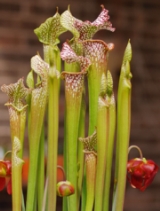
Sarracenia leucophylla
Encyclopedia
Sarracenia leucophylla, also known as the white pitcher plant, is a carnivorous plant
in the genus
Sarracenia
. Like all the Sarracenia, it is native to the New World
and inhabits moist and low-nutrient longleaf pine (Pinus palustris) savannas along the United States Gulf Coast, generally west of the Apalachicola River
on the Florida Panhandle
. The species is highly variable with respect to its pitchers, with plants in some localities reaching almost 1 metre in height, while in others, plants can be diminutive (such as the seldom seen 30 cm high dwarf form encountered at Garcon Point in Santa Rosa County, FL). S. leucophylla produces crimson flowers in the spring before its characteristically small spring pitchers. These are generally followed midsummer with flat non-carnivorous leaves known as phyllodia. Its most robust and handsome pitchers are then produced in the early autumn. It is one of the largest and showiest Sarracenia species, which has made it vulnerable to poachers as well as interest from the floral trade, in which the cut autumn pitchers often find use in arrangements. However, as is the case with most Sarracenia species, the greatest threat to S. leucophylla is loss of its unique wetland habitat to development along the Gulf Coast, as well as forest succession that was historically kept in check by fire.
In cultivation, S. leucophylla is generally less tolerant of stagnant water conditions and requires adequate soil drainage while still retaining requisite moisture levels to prevent root rot. Several clones are recognized: 'Schnell's Ghost', a yellow-flowered clone with little red in the pitchers (though not anthocyanin
free); 'Hurricane Creek White', a group of predominantly white plants from Hurricane Creek, AL; 'Tarnok', a mutant form which produces a showy, although sterile, double flower; and 'Titan', an especially tall and robust form that may produce fall pitchers greater than 38 inches (97 cm) in height. Despite its native range in the southeast US, S. leucophylla is remarkably hardy and can be grown outside even in USDA zones
6 and colder with careful winter protection.
Carnivorous plant
Carnivorous plants are plants that derive some or most of their nutrients from trapping and consuming animals or protozoans, typically insects and other arthropods. Carnivorous plants appear adapted to grow in places where the soil is thin or poor in nutrients, especially nitrogen, such as acidic...
in the genus
Genus
In biology, a genus is a low-level taxonomic rank used in the biological classification of living and fossil organisms, which is an example of definition by genus and differentia...
Sarracenia
Sarracenia
Sarracenia is a genus comprising 8 to 11 species of North American pitcher plants. The genus belongs to the family Sarraceniaceae, which also contain the closely allied genera Darlingtonia and Heliamphora....
. Like all the Sarracenia, it is native to the New World
New World
The New World is one of the names used for the Western Hemisphere, specifically America and sometimes Oceania . The term originated in the late 15th century, when America had been recently discovered by European explorers, expanding the geographical horizon of the people of the European middle...
and inhabits moist and low-nutrient longleaf pine (Pinus palustris) savannas along the United States Gulf Coast, generally west of the Apalachicola River
Apalachicola River
The Apalachicola River is a river, approximately 112 mi long in the State of Florida. This river's large watershed, known as the ACF River Basin for short, drains an area of approximately into the Gulf of Mexico. The distance to its farthest headstream in northeast Georgia is approximately 500...
on the Florida Panhandle
Florida Panhandle
The Florida Panhandle, an informal, unofficial term for the northwestern part of Florida, is a strip of land roughly 200 miles long and 50 to 100 miles wide , lying between Alabama on the north and the west, Georgia also on the north, and the Gulf of Mexico to the south. Its eastern boundary is...
. The species is highly variable with respect to its pitchers, with plants in some localities reaching almost 1 metre in height, while in others, plants can be diminutive (such as the seldom seen 30 cm high dwarf form encountered at Garcon Point in Santa Rosa County, FL). S. leucophylla produces crimson flowers in the spring before its characteristically small spring pitchers. These are generally followed midsummer with flat non-carnivorous leaves known as phyllodia. Its most robust and handsome pitchers are then produced in the early autumn. It is one of the largest and showiest Sarracenia species, which has made it vulnerable to poachers as well as interest from the floral trade, in which the cut autumn pitchers often find use in arrangements. However, as is the case with most Sarracenia species, the greatest threat to S. leucophylla is loss of its unique wetland habitat to development along the Gulf Coast, as well as forest succession that was historically kept in check by fire.
In cultivation, S. leucophylla is generally less tolerant of stagnant water conditions and requires adequate soil drainage while still retaining requisite moisture levels to prevent root rot. Several clones are recognized: 'Schnell's Ghost', a yellow-flowered clone with little red in the pitchers (though not anthocyanin
Anthocyanin
Anthocyanins are water-soluble vacuolar pigments that may appear red, purple, or blue according to pH...
free); 'Hurricane Creek White', a group of predominantly white plants from Hurricane Creek, AL; 'Tarnok', a mutant form which produces a showy, although sterile, double flower; and 'Titan', an especially tall and robust form that may produce fall pitchers greater than 38 inches (97 cm) in height. Despite its native range in the southeast US, S. leucophylla is remarkably hardy and can be grown outside even in USDA zones
Hardiness zone
A hardiness zone is a geographically defined area in which a specific category of plant life is capable of growing, as defined by climatic conditions, including its ability to withstand the minimum temperatures of the zone...
6 and colder with careful winter protection.

